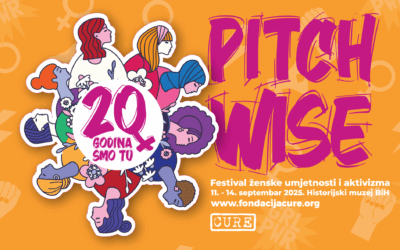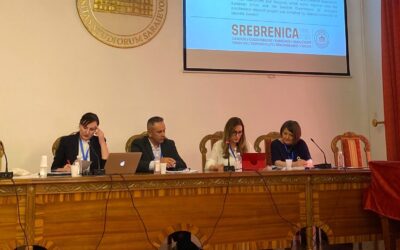– It was a very happy moment. After two years of war, and a life in exile I was for the first time back in Sarajevo. For 48 hours I had a chance to see my husband Goran, my dad and some friends. I was happy and sad and scared and brave, because I had the opportunity to see them, to talk with them. It left me feeling scared that I would not see them ever again, because I knew how awfully difficult it can be to survive.

Jadranka Milicevic
Jadranka Milicevic stands in front of 34 women from different conflict areas who have gathered in Stockholm to find out how storytelling can be a tool for outreach. They have all taken it in turns to tell a happy moment of their lives. Moments that has often meant overcoming hardship. The attention in the room is tangible.
– We all need to collect stories for our work and tell them. But usually organisations don’t have much knowledge on how to do it, says Jadranka who works for Cure, a feminist activist group in Bosnia and Herzegovina.
Åsa Carlman from Kvinna till Kvinna who has been coordinating the Storytelling seminar says that the seed for working on storytelling was the need for a stronger organisational memory:
– We have a lot of stories to tell but we are not so good at collecting them. Our stories leave with the persons who experienced them. Now we also know that when we are good storytellers it is easier to awake engagement, get funding, and strong results from our advocacy.
The silence is spreading in the room while everyone is concentrating on how to develop their story.
Between the readings the lively discussions move between whether the messenger is part of the message, how to break stereotypes and the demand for flesh and blood and happy endings.
Last year Kvinna till Kvinna launched the report “Insist Exist Resist Persist”, built on stories from women human rights defenders from all over the world.
– I use it very much when talking about women’s security and how to support sisterhood. I can use the story from a Colombian woman, and a woman from Bosnia recognise her self and says – That’s exactly how I felt!, says Jadranka, strong stories are really useful tools in our work. We still use the movie “Lilja Forever” from 2002 in schools to prevent young Roma women from being victims of trafficking for sexual exploitation.
This year Cure made a movie “I am a Roma Woman” on the positive stories of Serbia, Montenegro, Croatia, Macedonia, Bosnia.
– But in media, still the stereotype of an old, poor, miserable Roma women is used as illustration, says Jadranka.

Ruba Simaan
An organisations life and work is built on stories – about how it all started, the vision and mission. Stories are not only the history and backbone of organisations, they can also inspire others to join and support the organisation. When it is put as a story it makes it easier for us to remember it. It becomes emotional facts. Ruba Simaan work with communication and fundraising at Al Tufula in Israel.
– Here I learnt a lot from how the others wrote and told their stories. I recognized their conflict situations. It could have been Palestine, says Ruba, Now I’ve got tools to add situations as stories, to put some excitement in a report.
– I realised how important the personal perspective is to engage. At Cure our staff meetings often last a long time because there has to be room for our stories, says Jadranka.
– Every year Al Tufula has a retreat to plan for the next year and collect achievements from the past. Last year I made a slide show, and it got much more comments than a usual report. “When did this happen?”. Soon I will have a workshop with the women in the staff to develop our stories more.
Liv Fjellander
Freelance


